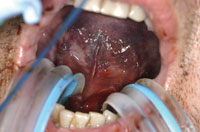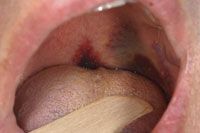Endo Accidents
A recent study by Clegg, et al1 comparing the efficacy of sodium hypochlorite, chlorhexidine, and Bio-Pure (DENTSPLY Tulsa) demonstrated that 6% sodium hypochlorite was the only root canal irrigant that could completely remove biofilm from the root canal system and prevent microbial growth. Despite this finding, fear of a sodium hypochlorite accident (Figures 1 to 3)2 still compels researchers to seek endodontic irrigants comparable to sodium hypochlorite in efficacy but without the risk of tissue destruction beyond the apical foramen.
 Figure 1.
Figure 1. Sodium hypochlorite accident following positive pressure irrigation of a maxillary posterior tooth. Note the panfacial vasculature effect. This is not typical of an inadvertent injection of sodium hypochlorite into the maxillary sinus when the patient only reports the taste of “bleach” at the back of the throat.
(Mehra P, Clancy C, Wu J. Formation of a facial hematoma during endodontic therapy. J Am Dent Assoc. Jan 2000;131:67-71. Copyright 2000 American Dental Association. All rights reserved. Reprinted by permission.)
 |  |
Figure 2. Sodium hypochlorite accident in the mandibular region. Note the widespread diffusion of sodium hypochlorite sublingually.
|
Figure 3. Widespread diffusion of sodium hypochlorite into the soft palate.
|
 Figure 1. Sodium hypochlorite accident following positive pressure irrigation of a maxillary posterior tooth. Note the panfacial vasculature effect. This is not typical of an inadvertent injection of sodium hypochlorite into the maxillary sinus when the patient only reports the taste of “bleach” at the back of the throat.
Figure 1. Sodium hypochlorite accident following positive pressure irrigation of a maxillary posterior tooth. Note the panfacial vasculature effect. This is not typical of an inadvertent injection of sodium hypochlorite into the maxillary sinus when the patient only reports the taste of “bleach” at the back of the throat.



Comentários
Postar um comentário